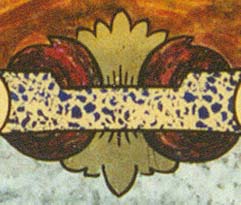Chemical Patination
Most metals will age and change their appearance with exposure to the elements. Different metals oxidize or tarnish in different ways and the raw shiny metal takes on a new character. The aim of chemical patination is to create an atmosphere or environment for the process to occur quickly.
The chemical patination of metal has been widely practised, however it's use with metal leaf on glass presents some special difficulties and has very little exploration.
With sculptural metalwork and surface gilding, the general procedure in is to use chemicals and environmental conditions. Most patination techniques require wetting the metal with the chemical cocktail, sometimes regularly for weeks and sometimes with heat. A huge range of colours and patination can be created. In general the result will be duller and weathered looking although some techniques produce bright interference colours like we see in heated metal. Variegated leaf is treated with heat to develop these interference colours.
There are thousands of different recipes around although many are variations on a theme with some of the same basic chemicals being used in different ways. Various metal salts combined with acids and/or ammonia will oxidise many metals. Silver often has a sulphur component used to tarnish it rather than by oxidation.
Most standard methods aren't really suitable for glass work because we are looking at the metal leaf through the glass. We need to patina the leaf before gilding it. The leaf is far too delicate to wet, so the only method open to us is a vapour technique.
Gold will not develop a chemically induced patina. We will confine ourselves to those metals available in leaf form suitable for gilding such as silver, copper and its derivatives.
 Schlag
leaf used in AGA crest.
Schlag
leaf used in AGA crest.
The small fan-shaped decorative element in centre of this piece was gilded using schlag with a grey patina. It was the result of a simple experiment with silver, copper and schlag (imitation gold) placed in a cabinet with heated acetic acid (vinegar). The leaf was loose and place on tissue and stacked so there was enough space for vapour circulation between each layer (15 - 20mm). The whole stack was covered with a box. A container with the acetic acid was set into the base and heated with a gentle flame. The acid vapour circulated through the cabinet and I let it sit for several days to develop.
The silver leaf showed no change. The copper leaf showed almost no change at the centre but at the edges there was an indication that it would develop a verdigris with more time. The schlag developed a good warm grey patina that was somewhat uneven in its development. The best section of schlag was later water gilded on the crest where it lost a little of its depth of colour.
The main difficulty in using it was its change in haptics. The leaf became very brittle and almost impossible to handle as it would break at the slightest tension. It seemed to have lost its structural integrity, like a burnt piece of paper. It would still hold together until you touched it and then it would crumble.
Theory
The schlag may not be suitable because it is a composite metal and it seems one component (possibly zinc?) is attacked to detriment of its structure. Silver and copper look like the most promising for a vapour technique.
Copper should develop a verdigris (blue/green color oxide on brown base) in an atmosphere of acid and ammonia. Many recipes for sculpture use variations of copper nitrate, nitric acid and ammonia. With our vapour technique we can eliminate the salt. We should also be able to use other acids as effectively, perhaps common acetic acid with household ammonia. Verdigris will take an appreciable time to develop though.
A sulphur based recipe for silver should work. This could be flowers of sulphur or a metal sulphide in water. WARNING: sulphides combined with acids will liberate toxic hydrogen sulphide gas (rotten egg gas) which can be fatal in high doses.
A safe, home style method could use egg, onion or garlic vapour for a few days. Silver is also turned a mid brown when oil gilded, probably due to sulphur in the varnish/goldsize. It may have a use in some limited circumstances. My desire is to develop a rich deep purple/black on silver.
Despite the difficulty of viewing the back of the leaf through glass, it may still be worth trying to get a satisfactory result by treating the metal after gilding onto the glass. It may work in some cases although another potential difficulty is the chemicals attacking the metal ions in the glass itself.



